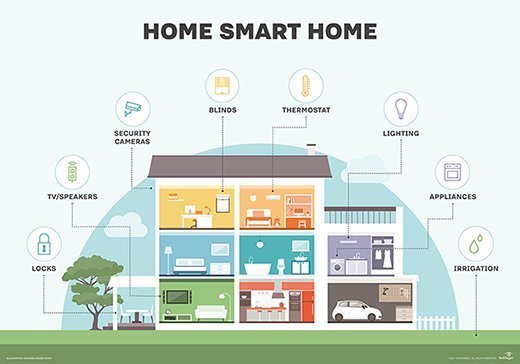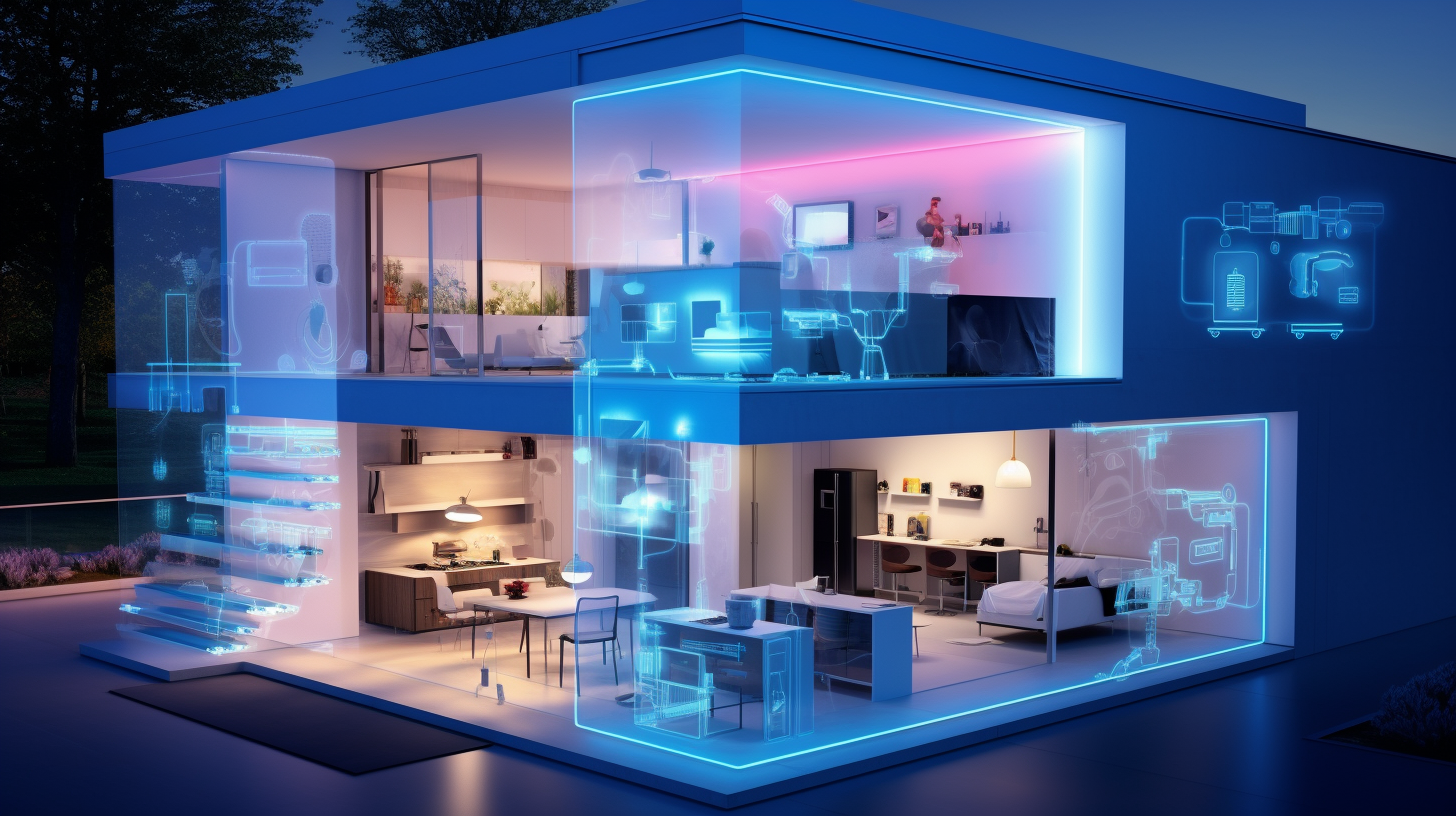Smart Home Essentials: Transform Your Living Space Today
- Update Time : Friday, October 25, 2024

Smart Home technology centralizes device control for convenience and efficiency. It integrates home appliances for automated and remote operations.
Embracing the era of connectivity, Smart Home systems revolutionize daily living by making home management a seamless experience. With the touch of a button or a simple voice command, lights, heating, and even kitchen appliances can be controlled. This innovation not only enhances comfort and convenience but also offers substantial energy savings and security benefits.
Homeowners can monitor and adjust their home settings from anywhere, ensuring peace of mind. Smart Home technology is a testament to the advancement of the Internet of Things (IoT), bringing sophisticated and user-friendly solutions to the residential domain. As this technology evolves, it promises to deliver even greater integration, making the homes of the future more responsive and adaptive to our needs.

Credit: www.techtarget.com
Introduction To Smart Home Technology
Smart homes are revolutionizing how we live. Connected devices make life convenient and efficient. From automating daily tasks to enhancing security, the benefits are vast. Smart homes allow for remote control of appliances and systems. This leads to significant energy savings and cost reductions. Comfort levels increase as these homes adapt to our lifestyles. Accessibility is also improved for those with limited mobility. The rise of smart homes marks a shift towards more intelligent living spaces.
| Smart Home Benefits |
|---|
| Energy Efficiency |
| Enhanced Security |
| Convenience |
| Cost Savings |
| Comfort |
| Accessibility |
Core Components Of A Smart Home
The heart of a smart home is its hubs and controllers. These devices connect and manage all smart components. Users control settings with voice commands, smartphones, or automatically through set rules.
For communication, smart homes rely on Wi-Fi, Zigbee, or Z-Wave protocols. Each protocol has unique features. Wi-Fi is common and easy to set up. Zigbee and Z-Wave use less power and can connect many devices.
| Protocol | Feature | Use Case |
|---|---|---|
| Wi-Fi | Widespread use | Streaming, control |
| Zigbee | Low power, secure | Sensors, switches |
| Z-Wave | Long range | Locks, lights |
Essential Smart Devices For Every Home
Smart Lighting Systems change how we light our homes. They let us control lights with our phones or voice. You can set them to turn on or off at certain times. This saves energy and money. Changing colors to match your mood is fun too.
Intelligent Thermostats make our homes comfy. They learn our temperature likes. This helps them adjust the heating or cooling automatically. It’s great for keeping the house perfect without touching a thing. Also, they cut down on energy bills. We control them from anywhere using our phones.
Enhancing Home Security
Smart locks change how we enter homes. No keys needed. Just a code or a phone app. It’s safe and easy. You can even give temporary access to friends.
Access control means only people you allow can enter. You can see who comes and goes. This keeps your home secure.
Video doorbells let you see who’s at the door, even when you’re not home. You can talk to them too. It’s like having a guard at your door.
Surveillance cameras watch over your home. They record everything. You can watch the videos on your phone. This helps catch bad guys.
Smart Entertainment For Modern Living
Embrace the future with smart entertainment in your home. Picture yourself controlling music with just your voice. Voice-controlled speakers make this possible. Kids and adults alike find them easy to use. Seamless integration with various smart home systems is a key feature.
Streaming devices and smart TVs transform how we watch shows and movies. Access your favorite content with a simple command. These devices often come with parental controls for peace of mind. They support numerous streaming services, offering endless entertainment options.
| Device Type | Key Feature | User-Friendly |
|---|---|---|
| Voice-Controlled Speakers | Easy music control | Yes |
| Streaming Devices | Access to various services | Yes |
| Smart TVs | Command your favorite shows | Yes |
Smart Appliances: A Kitchen Revolution
Smart homes are transforming kitchens with innovative appliances. The smart refrigerator now offers features like inventory tracking and expiration notifications. Users can also remotely adjust settings or check contents via smartphone apps. Smart ovens are changing the way we cook, with capabilities for remote preheating and cooking notifications.
Automated coffee makers and blenders simplify morning routines. They learn preferences and adjust strength or blend accordingly. Some can even reorder ingredients when supplies run low. These devices are not just convenient; they ensure a consistent quality of your favorite beverages.
Home Automation And Energy Efficiency
Smart homes are revolutionizing the way we manage energy. Energy monitoring systems provide real-time data on electricity usage. This helps to identify and reduce excess consumption. Systems can track usage across different devices and times of day. Insights from this data can lead to substantial energy savings.
Automated blinds and climate control work together to optimize home temperatures. On sunny days, blinds adjust to block excessive heat, reducing air conditioning needs. During winter, they let in sunlight, minimizing heating requirements. Smart thermostats learn your preferences, making adjustments to save energy while maintaining comfort.
The following table provides a quick glance at the features and benefits of both systems:
| Feature | Benefit |
|---|---|
| Energy Monitoring | Cuts down costs |
| Automated Blinds | Controls sunlight |
| Smart Thermostats | Adjusts home temperature |

Credit: webberstudio.com
Setting Up Your Smart Home
Planning your smart home layout is key to a seamless experience. Think about which rooms need smart devices. Your living room, kitchen, and bedroom are great starts. Map out where each device will go. This makes installation easier.
Installation tips and tricks: Always read the manual first. It has important info. Use your phone to download smart home apps. They help control devices easily. Group devices by room in the app for simple management. Check your Wi-Fi strength. All devices need a strong connection. Sometimes, Wi-Fi extenders are needed. Lastly, update devices regularly for new features and security.
Troubleshooting Common Smart Home Issues
Connectivity issues in smart homes often stem from weak Wi-Fi signals. To address this, ensure your router’s firmware is up to date and consider a Wi-Fi extender to boost coverage. Resetting devices can also re-establish lost connections.
For device compatibility, always check the manufacturer’s specifications before purchase. Regular firmware updates are vital for smooth operation and can be found on the device’s app or website. Outdated firmware may lead to compatibility issues, so keep your devices current.
The Future Of Smart Homes
The smart home landscape is rapidly evolving, with cutting-edge technologies surfacing each day. AI and machine learning play pivotal roles, transforming how devices communicate and learn from user habits. These advancements lead to more intuitive and efficient homes.
Consider smart thermostats that adjust temperatures based on your routine, or fridges that suggest recipes based on their contents. Security systems now identify familiar faces, reducing false alarms. Voice assistants have become more responsive, offering personalized experiences. All these improvements stem from AI’s deep learning capabilities.
| Technology | Benefits |
|---|---|
| Smart Thermostats | Energy Efficiency, Comfort |
| Intelligent Fridges | Meal Planning, Inventory Tracking |
| Advanced Security | Enhanced Safety, Peace of Mind |
| Voice Assistants | Convenience, Personalization |
:max_bytes(150000):strip_icc()/smart-home.asp-final-5de0da3d6d8a474f9028d26c957255fe.png)
Credit: www.investopedia.com
Frequently Asked Questions
What Is A Smart Home?
A Smart Home refers to a residence equipped with devices that automate tasks normally handled by humans. These devices are interconnected and can be controlled remotely via smartphones or voice command, enhancing home security, energy efficiency, and convenience.
How Do Smart Homes Save Energy?
Smart Homes save energy by utilizing intelligent devices like thermostats and lighting systems. These devices adjust energy usage based on patterns and preferences, significantly reducing unnecessary power consumption and contributing to lower utility bills.
Can Smart Home Devices Improve Security?
Yes, Smart Home devices can significantly enhance security. They include smart locks, cameras, and alarm systems that can be monitored and controlled remotely, providing real-time updates and alerts to homeowners for increased peace of mind.
What Are The Best Smart Home Devices?
The best Smart Home devices typically offer reliability, user-friendliness, and compatibility with other smart systems. Popular choices include smart speakers, thermostats, lights, locks, and security cameras from reputable brands like Google, Amazon, and Philips Hue.
Conclusion
Embracing smart home technology offers convenience, security, and energy efficiency. As we’ve explored, integrating intelligent devices can significantly enhance your living experience. Remember, a well-connected home adapts to your lifestyle, providing comfort and peace of mind. Start small, choose compatible gadgets, and step into the future of home living.


















Leave a Reply